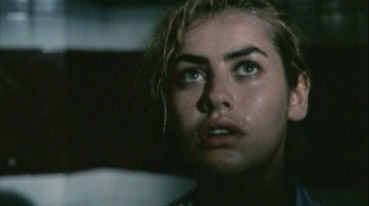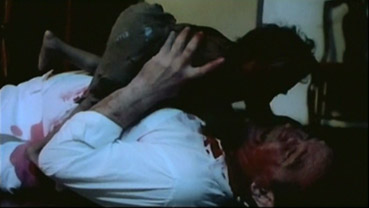|
Here's one for you. What do you get if you cross a rat with a monkey? Ratman is what, the diminutive but fearsome-toothed creature at the heart of the film bearing his name. Actually, given his size, Ratboy might have been a more appropriate moniker, but that one was snagged two years earlier by one-time Clint Eastwood companion Sondra Locke for her horribly misfired 1986 take on Peter Bogdanovich's already horrible 1985 wannabe weepie Mask. Then again, the original Spanish title is not Ratman anyway but Quella villa in fondo al parco, which translates roughly as That Villa at the Bottom of the Park. A Villa located in the sunny Caribbean. A villa where Ratman lives.
Well maybe not lives. A creation of British ex-patriot Dr. Alman, he's kept in a tiny cage in the Doc's ramshackle laboratory, an experiment the delusional old fool believes will win him the Nobel Prize. The Nobel Prize for what, exactly? His assistant Tonio is concerned that Ratman is eating raw meat and has grown strong over the past month, but the Doc's not worried about that. Seconds later, the creature has escaped and is on the prowl for human flesh.
Enter photographer Mark and his two models Marilyn and Peggy, who are prancing about on the beach under the concealed Ratman's gaze. They find the remains of a body but decide not to report it. Why? Because Mark doesn't want to be held up answering a lot of questions. OK, so he's asked for trouble there. What will it take to seal the deal? Well wouldn't you know it, Peggy is due to head back to New York tomorrow and is really, really looking forward to it. Uh-oh...

A short while later, the authorities find a woman's torn and chewed corpse, and in flies a girl named Terry to identify what she has been told are the remains of her sister Marilyn. But it's not Marylin at all but the unfortunate Peggy, who never did make it back to New York. Terry decides to stay on and find her sister, who is now rumoured to be off in the jungle on a photoshoot with Mark ("That's it! Beautiful!") and new model Monique. Terry's aided in her quest by Fred Williams, a square-jawed buffoon who apparently writes TV mysteries. I'll bet they're really good. For top-of-the-cast-list characters, these two are as ineffectual a pair as you'll encounter all year. They flutter like curious moths around the edge of a drama that they never really become part of, conducting an investigation that consists largely of guesswork that leads to nothing, or sees the pair of them arrive too late to be of any use to anyone.
I'm making the plot sound more complicated than it is. It all boils down to the horror movie basics of isolating a small group and terrorising them with a deadly monster. And it is deadly too. Ratman not only has razor-sharp teeth and claws, but carries within him a deadly toxin that makes even a single scratch fatal. That should secure the Nobel Prize win, Doc. Just what the world needs, a highly toxic predatory rat-monkey.
There are no real surprises or even half-clever plot twists here, and characters do tend to behave in a generically programmed manner. Clothes come off for a semi-orgasmic shower (that Ratman is watching from outside, of course), and when Alman and Marilyn are on the verge of driving to safety, the Doc suddenly remembers he's left his research papers inside and trots stupidly back into slaughter central to get them, leaving pretty Marilyn alone on her own for a final showdown with the ugliest monster you'll see all year.
And therein lies Ratman's chief attraction, the ingredient that almost prompts you to forgive its plastic characters and dopey plot. Ratman is a creature worthy of such a name, truly horrible in appearance and disturbingly undersized for a humanoid creation. So small is he, indeed, that I began to suspect that director Giuliano Carnimeo had exploited an uncharacteristically well-behaved and obedient two-year-old (good on him, I say). The character was actually played by Nelson De La Rosa, the world's smallest actor and, until his death, a close runner for the badge of smallest person on the planet. Not all of his appearances are as unsettling as they could be, but every now and again Carnimeo puts him to suitably creepy use, notably when he scuttles up the curtains in Marilyn's bedroom or peeks through the floorboards at Peggy, who's hiding in a cupboard from a narrative red herring.

For all its daftness and playing to formula, Ratman still has its moments. Mark's discovery of something strange in the background of one of his beach photos may not be Blow Up, but is still rather effective in the way such things are, and the image of the creature crawling out of a toilet bowl had me checking under the loo seat for days. The music score at times has a nicely giallo ring, and the climactic sequence in which a terrified Marilyn barricades herself in a room and is nailed in big close-up as she is terrorised by the sounds of exterior scuttling is really well done. And it may play like the mother of low budget compromises to some, but I thought the freeze-frame, scream-accompanied ending was an absolute blast.
An opening title card informs us that the print included here is the most complete version ever and that it was constructed from "a variety of sources, some good, some not so good." A more accurate rephrasing might be "some not so good, some even weaker." The picture is consistently soft and the contrast varies between not-at-all-bad and rather poor, depending on the state of the source material. Shadow detail on the weaker sequences is almost non-existent, rendering a few shots completely incomprehensible. All of which will no doubt earn the transfer a slamming from the high-def brigade, most of whom probably wouldn't touch Ratman with a cattle prod anyway. But hardened horror fans will appreciate that rescuing and restoring lesser-known genre works to their near-complete form on what is likely a tiny budget does sometimes mean making a few sizeable compromises, and the print of Ratman is one of them. It's still a shame, of course, as there are whole scenes that would have doubtless have been rendered creepier had you been able to clearly see what was going on. On the plus side the transfer is anamorphic, and there's hardly a dust spot to be seen.
The mono 2.0 soundtrack is in similarly imperfect shape, the background hiss and crackle at times threatening to move into the foreground. This, combined with the slightly muffled quality of the dialogue, deceived me into thinking that the Doc's opening narration was an old wartime BBC radio broadcast.
Just the Theatrical Trailer (1:05), which I can't help but suspect was assembled by the guys at Shameless. Either way, it's a very smartly edited and persuasive sell.
This one's aimed at – and frankly will probably only be appreciated by – the dedicated fans of 1980s horror and specifically those with a giallo bent. To be honest they're probably going to be the only ones who are going to be sympathetic to the print and transfer issues – we'll put up with a lot to get the full version, or at least one as near to full as dammit. And if that description applies to you then Ratman may just have enough going for it to tickle your horror fancy.
|